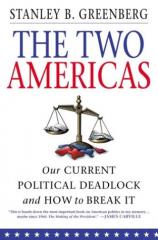The Two Americas: Our Current Political Deadlock and How to Break It
Review
The Two Americas: Our Current Political Deadlock and How to Break It
Anyone who picks up a book on the current state of party politics
in the U.S.A. is compelled to take note first of the author's
political stance. Stanley B. Greenberg, author of THE TWO AMERICAS,
was a pollster for Bill Clinton and Al Gore and a key member of
Clinton's campaign team. He is married to a Democratic
congresswoman from Connecticut.
The same full-disclosure mandate surely applies to reviewers of
such books as well. OK, this reviewer is a registered Democrat, a
senior citizen/retiree, middle-class, Catholic New Englander
resident for many years in the Middle West.
Those preliminaries out of the way, perhaps we can get down to
reviewing the book.
Greenberg starts with the obvious: the electorate is evenly divided
between the two parties, a situation he regards as "ugly" and
unhealthy. Each party sees the possibility of breaking the deadlock
to its own advantage, but neither seems able to pull the trick off.
Using the pollster's standard tools of interviews, focus groups and
projections, he slices and dices both parties into interest groups
according to age, education level, income, religious feelings and
geographical distribution. His text is full of bar charts and
"thermometers" that register the feelings of each sub-group on all
sorts of questions. He traces the history of America's shifting
political allegiances, in particular those of the past 50 years, a
period when neither party was able to achieve any lasting dominance
(or, to use his favorite word, "hegemony").
Seeking out middle ground between the parties, he devotes special
attention to three typical geographical areas where neither party
dominates --- the suburbs east of Seattle, the farm country of
central Iowa and suburbs around Tampa. Then he lays out a potential
victory strategy for each party, and concludes that whichever one
takes advantage of his insights will have victory within its
grasp.
It is in this last section that Greenberg's own bias is evident.
His Republican victory strategy amounts largely to the GOP
energizing its core loyalists and adding enough fringe voters to
them to ensure a win. He convenes a fictional meeting of George W.
Bush's campaign team at which Bush is largely a mute bystander,
more interested in catching a baseball game on television. But for
the Democrats, Greenberg lays out a detailed campaign platform
designed to appeal to middle class and uncommitted voters whom he
feels the party has lost in recent years. He believes the 2004
election will be decided fully as much on "cultural" issues (guns,
religious feeling, education level, "family values") as on
substantive issues like health care or foreign policy.
He has critical things to say about each party's strategy in recent
elections: the Republicans have pushed an agenda (tax cuts, small
government) in which most voters are simply not interested, the
Democrats have given up on the middle class, where much of their
strength should lie. Many voters, he finds, are alienated from the
Republicans but aren't attracted to the Democratic
alternative.
All of this is certainly provocative. What one makes of it will
depend largely on whether one thinks pollsters are the infallible
seers they advertise themselves as, or just educated estimators of
the public mood. I suspect the strategists of both parties will
comb through this book for usable tactics, without necessarily
swallowing it whole.
There are a number of factors in play that Greenberg either ignores
or mentions only in passing. He has little or nothing to say about
the obvious public alienation from politics in general reflected in
declining turnout, the impact of television on modern campaigns,
the rampant weakening of party loyalty out there beyond Washington
D.C., the baleful influence of partisanship-driven redistricting,
the obvious financial advantage held by the Republicans, the
possible impact of additional campaign finance reform on future
campaigns, or such a wild-card issue as abortion. And of course he
is handicapped by not knowing as he writes the identity of the
Democratic nominee for 2004.
This is an earnest and interesting book, one that political junkies
(like me) will devour like manna from heaven. Much of its data,
however, could be invalidated overnight by some unforeseen event or
sudden shift in the political winds. It's still a long time until
election day, folks.
Reviewed by Robert Finn (Robertfinn@aol.com) on January 24, 2011
The Two Americas: Our Current Political Deadlock and How to Break It
- Publication Date: January 8, 2004
- Genres: Current Affairs, Nonfiction
- Hardcover: 288 pages
- Publisher: Thomas Dunne Books
- ISBN-10: 0312318383
- ISBN-13: 9780312318383



